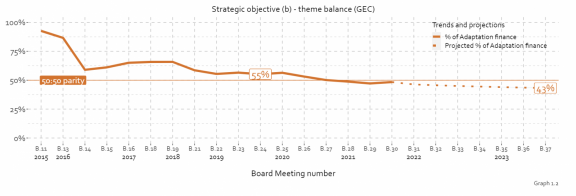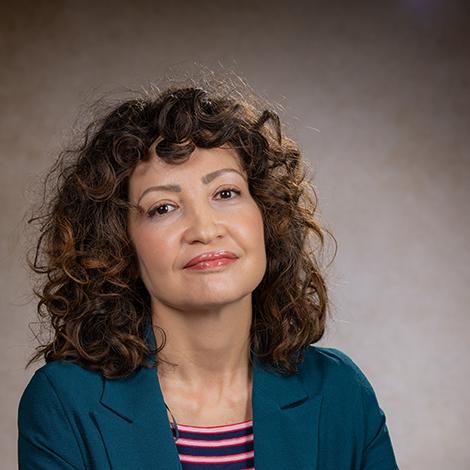B.32 Data Outlook: Funding proposals for Board's consideration
From 16 to 19 May 2022, the 32nd Meeting of the GCF Board (B.32) [1] will take place in Antigua and Barbuda. This is the first in-person Board meeting to take place since the COVID-19 outbreak in 2020. This meeting takes place at a critical juncture of global COVID-19 recovery efforts, a volatile geopolitical landscape, and intensified climate impacts.
Newly proposed funding proposals (FPs)
During B.32, four new projects will be presented for the Board’s approval, along with one project for a second tranche approval. Most of the four new projects are small to medium size mitigation projects to be implemented in the Asia-Pacific region. If all funding proposals including the second tranche request are to be approved at B.32, low-emission transport will receive the largest portion of GCF funding of USD 200 million (62 per cent of the total funding to be approved at B.32), followed by energy renewal at USD 35 million (11 per cent). Ecosystem and ecosystem services will receive USD 16 million, or 5 per cent. ‘Forestry and land use’ and ‘infrastructure and built environment’ will be the two results areas with no GCF funding approved at this Board meeting. If all four FPs and the second tranche request are to be approved at B.32, two projects will be implemented by direct accredited entities working at regional and national levels. Targeting of women is foreseen at 45 to 50 per cent of the total indirect or direct beneficiaries. According to the implementing entities, these initiatives are projected to have an impact and paradigm shift potential above the average rating.[2] A complete list of the new projects being tabled at B.32 is provided in Box 1 below.
Of these projects,[3] USD 64 million is being requested for adaptation (20 per cent) and USD 261.2 million for mitigation (80 per cent) in nominal terms. If the proposed projects are to be approved, the GCF’s portfolio will continue to be imbalanced towards mitigation, relative to the Fund’s vision to achieve a balanced portfolio between mitigation and adaptation (See Figure 1).
Figure 1. Projected portfolio balance (balance between adaptation and mitigation commitments). Percentage of adaptation commitments out of total
Source: Analysis done by the IEU DataLab
The GCF also strives for a reasonable and fair allocation of funding across a broad range of countries to ensure geographical balance. However, if the proposed projects are approved, three out of the four new projects will be implemented in Asia, furthering the gap between Latin America and Eastern Europe versus Africa and the Asia-Pacific (see Figure 2).
Figure 2. Regional distribution of GCF funding in USD
In terms of fund distribution among vulnerable countries, two of the FPs either wholly or partly target the least developed countries (LDCs), the small island developing States (SIDS), and the African States, totaling USD 49.9 million (or 15 per cent of the total GCF funding requested). In comparison, the GCF seeks to achieve a floor of 50 per cent of the allocated adaptation funding for the LDCs, SIDS, and the African States.
Of the proposed projects, two will be implemented by the private sector, and the GCF’s private sector engagement will reach 15 per cent of the total GCF accumulated finance. This is still low compared to the GCF’s goal to engage the private sector at 20 per cent of its portfolio level during GCF-1, relative to the Initial Resource Mobilization (IRM) period (See Figure 3).
Figure 3. Project of the % of private sector commitments out of total GCF finance
Source: Tableau server iPMS data, as of B.30 (8 October 2021), analysis done by the IEU DataLab
Accreditation
Of the five projects, two projects are from direct access entities (DAEs), which equate to USD 75.3 million, or 23 per cent in nominal terms. And the rest are from international accredited entities (IAEs) at USD 249.9 million, or 77 per cent, in nominal terms. This follows the general trend in GCF – the share of DAEs remains relatively lower than that of IAEs, with only 21 per cent of the total GCF funding being channeled through the DAEs.
Striving for transformational change
How will these projects contribute to a paradigm shift?[4] According to an IEU learning paper on the likelihood of impact of GCF investments towards a paradigm shift in green transformation, its adaptation and cross-cutting projects showed a greater need for behaviour change relative to mitigation projects. Moreover, the adaptation projects showed greater intention to integrate policy change into national planning processes than the mitigation and cross-cutting projects, while demonstrating a similar likelihood of catalyzing policy change. A multivariate cluster analysis done in the paper shows that the GCF’s adaptation projects are more likely to be transformational, compared to its mitigation or cross-cutting projects.
The proposed projects’ scorecards prepared by the accredited entities concerned for B.32 seem to converge with the findings of the abovementioned learning paper as well. For instance, the adaptation project ‘FP184: Vanuatu community-based climate resilience’ has the highest rating for the paradigm shift potential in green transformation (score 4.6) but rates below average for sustainability (3.4). The mitigation project ‘FP186: India E-Mobility Financing Program’ scores the highest on national ownership (average score 4.7) but scores low on effectiveness and efficiency (3.6) and impact (2). The Galapagos project (FP185) has the lowest efficiency and effectiveness rating (3).
If these projects get approved and become part of the GCF’s portfolio, the initial projections indicate potentially positive trajectories as well as potential risks with regards to project effectiveness, efficiency, impact, and sustainability. The latter in particular provides important insights for guiding the GCF’s support to countries to help achieve a global paradigm shift toward low-carbon and climate-resilient futures.
Box 1. List of FPs being tabled for Board’s consideration at B.32
|
(1) Spanning over 20 years, the project “Climate Change: The New Evolutionary, Challenge for the Galapagos” (FP185) aims for a transformational change toward a self-sufficient island system, while developing local livelihoods under a low-carbon model and enhancing the capacity to adapt to climate change. Covering both mitigation and adaptation, the project has a national co-financing of 52 million USD (45 per cent) and a GCF contribution of 65 million USD or (55 per cent) of the total project budget of USD 118 million. Implemented by a national regional entity, Corporación Andina de Fomento (CAF), the project aims to target around 1 million direct and indirect beneficiaries. Over the 25-year lifespan of the technology, emissions reductions will reach 584,168.98 tCO2e. (2) The adaptation project ‘Vanuatu community-based climate resilience project (VCCRP)’ (FP184) plans to support, over 6 years, highly vulnerable rural communities across 29 Area Councils in Vanuatu. The project seeks to increase their resilience to climate variability and change by implementing targeted adaptation actions and facilitating decentralized governance structures that enable rural populations to adapt to changing climate trends and reduce disaster risk. Of the total of USD 32 million, the project will have a national co-financing of USD 6 million (20 per cent) and a GCF contribution of USD 26 million (80 per cent). The total number of direct and indirect beneficiaries is projected at 300,000, with an average of 45 per cent of women. The project will be implemented by Save the Children Australia (SCA). (3) SAP024: Pakistan Distributed Solar Project (PDSP) aims to promote financing and lending solutions for Solar PV products, particularly distributed generation. The project is designed to provide an innovative intervention to tackle existing climate mitigation barriers, whilst creating an enabling environment for climate-resilient infrastructure in the country. Spanning over 34 years, it aims to contribute directly to the mitigation results areas of energy access and power generation. The total financing of USD 54 million is divided between 44 million in co-financing (81 per cent) and GCF's expected contribution of USD 10 million (9 per cent). The reduction in CO2 tons is estimated at 848,700. The implementing entity is JSBank, a national private entity. (4) The India E-Mobility Financing Program (FP186) will be implemented over 10 years and aim to leverage the GCF funding and commercial investor capital to accelerate the decarbonisation of the Indian economy by focusing on the electrification of India’s transport sector. This will be enabled by supporting faster adoption of electric vehicles and growth of associated infrastructure, replacing, and limiting the new purchase of, traditional Internal Combustion Engine (ICE) vehicles contributing to the result area of low-emission transport. The total budget of USD 1.5 million is divided between a co-financing of USD 1.2 million (85 per cent) and an expected GCF contribution of USD 200,000. The reduction in CO2 tons is estimated at 9,517,000. The project will be implemented by Macquarie Alternative Assets Management Limited (MAAML). (5) The Secretariat is also submitting to the GCF Board a request by Deutsche Gesellschaft für Internationale Zusammenarbeit GmbH (GIZ) for the second phase of the Climate-Friendly Cooking: Kenya and Senegal. Planned to be implemented over 3 years, the project will address policy gaps in market development for climate-friendly cookstoves in Kenya and Senegal and share knowledge about climate-friendly cooking solutions among relevant countries. The results areas concerned are buildings, cities and industries, and appliances. With total financing of USD 36 million, the project has secured a 12 million national co-financing (35 per cent) and is requesting a GCF contribution of 24 million (65 per cent). Emissions reductions will reach 5,588,650 tCO2e. |
[1] As the governing and oversight body of the GCF, the GCF Board functions independently and is guided by the Conference of the Parties (COP) to the UN Framework Convention on Climate Change (UNFCCC).
[2] The proposed projects by type were: 1 adaptation, 3 mitigation and 1 cross-cutting
[3] The project is rated for the likelihood of achievements in the domains of impact, ownership, sustainability, paradigm shift, needs of recipients, effectiveness and efficiency, using a scoring methodology. Rating is in the range of 1-5 (1 the lowest and 5 the highest), and a 3.5 rating is considered above average.
[4] According to the GCF's Governing Instrument, the Fund's mandate is to promote a paradigm shift toward low-emission and climate-resilient development pathways.
Disclaimer: This guest blog was originally published by the author. The views expressed in this guest blog are the author's own and do not necessarily reflect the views of the Independent Evaluation Unit of the Green Climate Fund.

